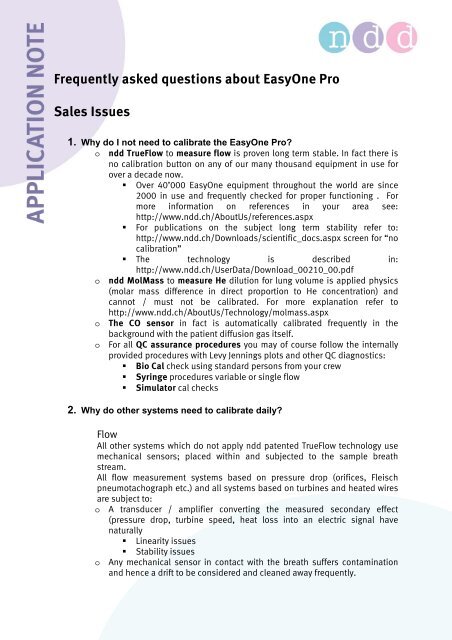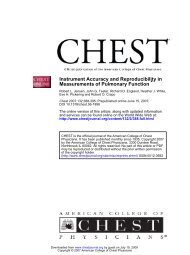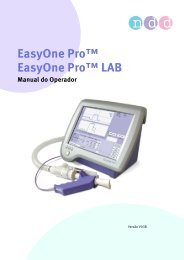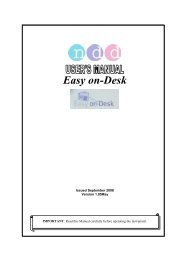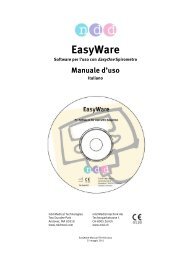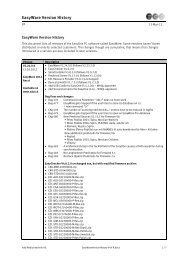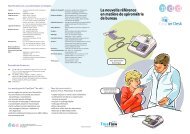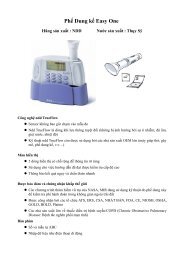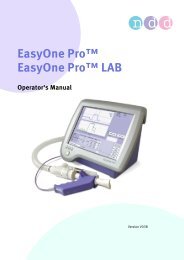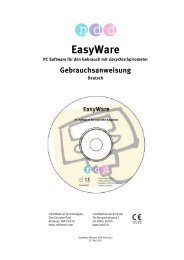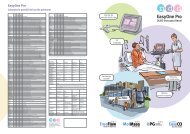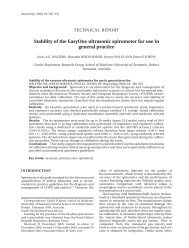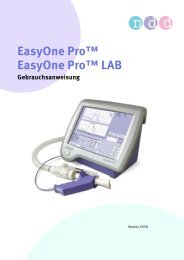Alternative applications of ndd spirette
Alternative applications of ndd spirette
Alternative applications of ndd spirette
Create successful ePaper yourself
Turn your PDF publications into a flip-book with our unique Google optimized e-Paper software.
Frequently asked questions about EasyOne Pro<br />
Sales Issues<br />
1. Why do I not need to calibrate the EasyOne Pro?<br />
o <strong>ndd</strong> TrueFlow to measure flow is proven long term stable. In fact there is<br />
no calibration button on any <strong>of</strong> our many thousand equipment in use for<br />
over a decade now.<br />
� Over 40’000 EasyOne equipment throughout the world are since<br />
2000 in use and frequently checked for proper functioning . For<br />
more information on references in your area see:<br />
http://www.<strong>ndd</strong>.ch/AboutUs/references.aspx<br />
� For publications on the subject long term stability refer to:<br />
http://www.<strong>ndd</strong>.ch/Downloads/scientific_docs.aspx screen for “no<br />
calibration”<br />
� The technology is described in:<br />
http://www.<strong>ndd</strong>.ch/UserData/Download_00210_00.pdf<br />
o <strong>ndd</strong> MolMass to measure He dilution for lung volume is applied physics<br />
(molar mass difference in direct proportion to He concentration) and<br />
cannot / must not be calibrated. For more explanation refer to<br />
http://www.<strong>ndd</strong>.ch/AboutUs/Technology/molmass.aspx<br />
o The CO sensor in fact is automatically calibrated frequently in the<br />
background with the patient diffusion gas itself.<br />
o For all QC assurance procedures you may <strong>of</strong> course follow the internally<br />
provided procedures with Levy Jennings plots and other QC diagnostics:<br />
� Bio Cal check using standard persons from your crew<br />
� Syringe procedures variable or single flow<br />
� Simulator cal checks<br />
2. Why do other systems need to calibrate daily?<br />
Flow<br />
All other systems which do not apply <strong>ndd</strong> patented TrueFlow technology use<br />
mechanical sensors; placed within and subjected to the sample breath<br />
stream.<br />
All flow measurement systems based on pressure drop (orifices, Fleisch<br />
pneumotachograph etc.) and all systems based on turbines and heated wires<br />
are subject to:<br />
o A transducer / amplifier converting the measured secondary effect<br />
(pressure drop, turbine speed, heat loss into an electric signal have<br />
naturally<br />
� Linearity issues<br />
� Stability issues<br />
o Any mechanical sensor in contact with the breath suffers contamination<br />
and hence a drift to be considered and cleaned away frequently.
� Some contamination like patient discharge may be filtered out, but<br />
this causes resistance and low flow threshold problems<br />
� Other effects like condensation <strong>of</strong> existing humidity are being<br />
formed regardless <strong>of</strong> filters and affect the measurement in a similar<br />
manner as contamination<br />
o Contamination builds up<br />
� And needs to be adjusted for<br />
� Needs to be cleaned away frequently and then re adjusted<br />
Gas composition<br />
All other systems which do not apply <strong>ndd</strong> patented Molar Mass technology<br />
apply some classical gas component measuring system.<br />
These gas sensors need to be calibrated using reference gases:<br />
o A basic calibration can be achieved uisng 2 reference gases<br />
o For higher quality 3 reference gases are required in order to take into<br />
account the non-linearity <strong>of</strong> the sensor.<br />
o hence involving complex calibration methods<br />
o and relying on the accuracy <strong>of</strong> locally supplied gases !!!<br />
Why is <strong>ndd</strong> calibration free?<br />
<strong>ndd</strong> applies the <strong>ndd</strong> patented TrueFlow and Molar Mass measurement which<br />
is uniquely different:<br />
Flow by <strong>ndd</strong> TrueFlow<br />
As implemented with EasyOne and meanwhile proven by evidence <strong>ndd</strong> True<br />
flow is “life time stable”.<br />
L td<br />
− tu<br />
F = ⋅<br />
2cosϕ<br />
t ⋅t<br />
d<br />
u<br />
A simple time measurement (<strong>of</strong> course calibration free, quarz based)<br />
measures the transit-times <strong>of</strong> ultrasonic pulses traveling up- and downstream<br />
the gas flow:<br />
o up-stream pulses are faster (i.e. smaller transit-time)<br />
o down-stream pulses are slower (i.e. larger transit-times)<br />
Using the above formula flow speed can be computed independently <strong>of</strong> any<br />
variables (temperature, humidity, ambient pressure, gas density etc.).<br />
Using flow speed the volume can be computed easily.<br />
Since there is no mechanical sensor in the gas stream, there is no<br />
maintenance, no drift, no effect <strong>of</strong> contamination.<br />
Gas composition by <strong>ndd</strong> Molar Mass<br />
The Molar Mass measurement determines the mean molar mass <strong>of</strong> the gas<br />
composition (i.e. the percentage weighted sum <strong>of</strong> all molar mass values <strong>of</strong><br />
the gas components).<br />
4 ⎛ tu<br />
⋅ td<br />
M = κ ⋅ R ⋅T<br />
⋅ 2 ⎜<br />
L ⎝ tu<br />
+ t<br />
d<br />
⎞<br />
⎟<br />
⎠<br />
2<br />
Molar Mass can therefore be used to measure changes in gas compositions.<br />
The molar mass measurement must not be calibrated and it is completely<br />
linear over its measurement range. We therefore do not need to calibrate with
the exception <strong>of</strong> CO, and this is done automatically and in a new way as<br />
explained below.<br />
EasyOne Pro measures:<br />
Flow and main-stream Molar Mass at the very same spot (same sensors) near<br />
patient.<br />
Helium by MolMass and CO by NDIR in a side stream arrangement.<br />
To have a precise time-alignment <strong>of</strong> all measurements (Flow, He, CO) the<br />
delay <strong>of</strong> each signal is automatically determined using a patented technology.<br />
The automatic delay correction is also calibration free and is performed for<br />
each test.<br />
He; Helium by Molar Mass<br />
We perform a 2 point calibration:<br />
1. Air being zero He<br />
2. Test gas being the working range maximum (concentration <strong>of</strong> the bottle<br />
as indicated by supplier)<br />
The absolute concentration is for <strong>ndd</strong> technology relatively unimportant since<br />
the relative Molar Mass measurement contains all the information needed to<br />
do accurate DLCO<br />
The absolute concentration is IMPORTANT for all simulator based<br />
measurements since the absolute concentrations <strong>of</strong> the reference gas bottles<br />
are compared to the absolute concentration <strong>of</strong> the DLCO test gas.<br />
The Molar Mass calibration is automatic an never requires any external gases.<br />
CO, Carbon Monoxide<br />
We perform an fully automatic 3 point calibration<br />
3. Air being the zero CO<br />
4. test gas being the working range max<br />
5. mid range: The exact gas mixture is determined by Molar mass and then<br />
used to calibrate the CO sensor at the mid point. Using this technology<br />
(patent pending) the non-linearity <strong>of</strong> the CO sensor can automatically be<br />
determined for each test.<br />
All calibration steps are fully automatic and with no need for any external gas.<br />
Ambient variables input<br />
No variables must be entered since all are either measured or irrelevant<br />
For the side-stream systems the humidity difference between inspiratory and<br />
expiratory measurements is equalized by conditioning <strong>of</strong> the sample to<br />
environmental level through Nafion® (parmapure) technology.<br />
3. How long does it take to set up EasyOne Pro “from scratch” and then<br />
every time I want to use it?<br />
o The first time the intuitive process (the proverbial 1,2,3) may take up to<br />
10 minutes, following the instructions in the manual<br />
� Connect the gas , the patient tube and adjust the regulator pressure<br />
� Connect the mains power (100-240VAC) and switch on<br />
� Run through the set-up routine
o Any subsequent times, including in different locations, it just takes 2-3<br />
minutes to be ready for measurements, no warm up, no checks, no<br />
maintenance and <strong>of</strong> course no calibration.<br />
4. How long does it take to measure one patient (LFT: spirometry and<br />
DLCO)?<br />
o It typically takes under 19 minutes for one patient: explanations,<br />
spirometry (BD) and DLCO in practical application with EasyOne Pro; on<br />
remote locations and similar in home site (reference by Respiratory Testing Services,<br />
Fremantle, WA, Australia; May 2009; timed on 2 locations with over 30 patients)<br />
o Important EasyOne Pro features for time saving:<br />
� Hand held sensor assembly, fast, easy and lip tight docking to<br />
patient, no positioning manipulation <strong>of</strong> support arms needed<br />
� Touch screen display, all operations and operator / patient<br />
interactions on the same screen<br />
� Customer designed report format and print out from main<br />
equipment (no PC required)<br />
� On board s<strong>of</strong>tware for data processing etc. (free export)<br />
� State <strong>of</strong> the art design: latest technology, latest hardware<br />
generations, windows based dedicated built-in PC<br />
5. What are the running costs for EasyOne Pro?<br />
o You will need a new <strong>spirette</strong> and barriette for hygienic reasons for each patient,<br />
for prices refer to the local source, usually well under USD 5. These are the ONLY<br />
consumable required.<br />
o The gas (0.3%CO; 10%He; 18-25% O2; N2) consumption is ca. 5 liters per<br />
inhalation, so typically 10-15 liters per patient<br />
o The power consumption is so low that you may easily use an uninterrupted power<br />
supply (UPS) for “total independence”: bed side, occupational sites etc.<br />
6. Why should I prefer <strong>ndd</strong> EasyOne Pro over other brands / models?<br />
o <strong>ndd</strong> is the company that has set the new standard in spirometry:<br />
� true flow (ultrasonic transit time measurement)<br />
� <strong>spirette</strong> the new hygienic consumable that allows calibration free<br />
(no sensor) use <strong>of</strong> TrueFlow based instruments.<br />
� References are published from Platino to BOLD, from USA to<br />
Australia<br />
o EasyOne Pro is the first and only instrument based on the new ATS/ERS<br />
standard for DLCO measurement<br />
o And developed by using the new ATS ERS approved simulator<br />
o EasyOne Pro features the same <strong>ndd</strong> benefits as does the word wide<br />
successful and best sold spirometer EasyOne:<br />
� No calibration<br />
� Ready to use at the touch <strong>of</strong> a button<br />
� Test QC monitored (and logged) for ATS / ERS compliance<br />
� User prompts to achieve best trials<br />
� Maintenance free, no service parts required,<br />
� but with a new and convincing trouble shooting concept; assuring<br />
help when and wherever needed and backing up the <strong>ndd</strong> promises.<br />
� It is the brand / instrument preferred by opinion leaders.
• By design <strong>of</strong> its patented technology TrueFlow and<br />
MolMass currently only available at <strong>ndd</strong> and a few selected<br />
OEM Partners.<br />
o You will always need only one gas, the DLCO diffusion gas (CO/He/Air),<br />
nothing else.<br />
7. Do you follow the ERS ATS 2005 guidelines<br />
o Yes, EasyOnePro is the first (and so far only) equipment that has been<br />
developed AFTER these guidelines were published. Therefore we match<br />
them better than anyone else.<br />
See:<br />
http://www.<strong>ndd</strong>.ch/Downloads/scientific_docs.aspx<br />
o Also we are conform with the Hans Rudolf Simulator developed by Crapo /<br />
Jensen. Published results: best out <strong>of</strong> 6 major brands.<br />
Technical Issues:<br />
8. What size <strong>of</strong> gas bottle should I order?<br />
o The size is a consideration between the following key aspects depending<br />
on your own preferences:<br />
• # <strong>of</strong> patients you want to measure per bottle<br />
• Usually the gas has a certified stability for 2-3 years<br />
• Ease <strong>of</strong> portability required (down to for example 5l for<br />
bedside)<br />
o Attention the filling pressure may be higher with big<br />
bottles (250atm with 20 and higher l) and lower with<br />
small bottles (150 atm. at 5l)<br />
9. Uninterrupted Power Supply (UPS) for EasyOne Pro<br />
o If the power supply has interruption or large Voltage Fluctuations a UPS<br />
units is necessary.<br />
o For specific calculation see:<br />
http://www.apc.com/tools/ups_selector/index.cfm<br />
Note the following specifications:<br />
� Power consumption EasyOne Pro: 80VA (Volt-Ampere, similar to<br />
Watt)<br />
� Use only a slow fuse <strong>of</strong> 3 Ampere.<br />
� The UPS need to supply 160Wh (Energy for a 2 hour power<br />
interruption)<br />
� For USP usually the Rating is indicated in Watt or VA this value<br />
need to be at least 80 VA<br />
� Depending <strong>of</strong> the lengths <strong>of</strong> the power interruption the backup time<br />
value is important. UPS provider indicate this value usually in<br />
Minutes (Example: 700VA � Back uptime 30 min with 50% load)
That means for EasyOne Pro (80VA) the backup time is around 2<br />
hours.<br />
o UPS Units can be bought in most electronic shops.<br />
10. Why are there He and CO curves during tidal breathing?<br />
o The MolarMass Signal is influenced by the MM <strong>of</strong> the Inspiration gas (MM=28.95<br />
g mol -1 ) and the MM <strong>of</strong> the expiration (MM=29.78 g mol -1 ). (Green Line) During<br />
tidal breathing. T his has nothing to do with Helium. ( No He gas apply during tidal<br />
breathing)<br />
o The purple line (CO) during tidal breathing is measuring the blank value which<br />
will be deducted in the exhalation.<br />
The scientists believe that during this tidal breathing phase both the He (Green Line)<br />
and the CO (Brown Line) should be flat. Yes but we use it to measure and calibrate the<br />
molar mass signal<br />
11. Does EasyOne Pro give the “same results” as the instrument(s) I<br />
am using currently, do the results match?<br />
o The issue <strong>of</strong> quality <strong>of</strong> DLCO results is a very complex one. A published<br />
ERS article deals with the aspects addressing this subject and is<br />
recommended reading for anyone concerned with quality issues:<br />
http://www.<strong>ndd</strong>.ch/UserData/Download_01471_00.pdf<br />
o EasyOne Pro is the first and so far only instrument that has been<br />
developed based on the ATS/ERS accepted standards <strong>of</strong> the Hans<br />
Rudolph (Crapo/Jensen) simulator (designed around 2005)<br />
o According to statements by the lead author <strong>of</strong> the above mentioned<br />
article EasyOne Pro is as close to the standards as he has seen it possible.<br />
And there is no calibration ! No “wrong” manipulation.<br />
o Another poster deals with the current situation <strong>of</strong> leading brands:<br />
http://www.<strong>ndd</strong>.ch/UserData/Download_00210_00.pdf<br />
o Your <strong>ndd</strong> dealer has a Hans Rudolph simulator available to make your<br />
evaluation easier and base it on the only internationally accepted standard<br />
available today.<br />
12. How does single breath DLCO compare to multi breath?<br />
o Single breath DLCO is the only DLCO method standardized by “ATS/ERS:<br />
Task Force; Standardization <strong>of</strong> Lung Function Testing” and as such the<br />
guide line: http://www.<strong>ndd</strong>.ch/UserData/Download_01384_00.pdf All<br />
considerations are dealt with in this publication.<br />
13. How does single breath TLC compare to other methods?<br />
o The relationship and circumstance are described in the publication linked<br />
here http://www.<strong>ndd</strong>.ch/UserData/Download_01468_01.pdf<br />
o If the TLC is "adjusted" with the Punjab equation, then RV would need to<br />
be recalculated. Since TLC = RV + VC, and using FVC as the VC then RV =<br />
TLC - FVC. This is simple, and the increase in RV will be equal to the<br />
increase in TLC due to the Punjab equation. So if the "Pre Punjab" TLC is
say 4.5 and FVC is 3.5 it follows that the RV is 1.0 (TLC - FVC) and it follows<br />
that RV/TLC ratio is 1.0/4.5 or 0.22. If the Punjab equation increases the<br />
TLC from 4.5 to say 5.0, FVC stays the same so the new RV = 5.0 - 3.5 =<br />
1.5, and the new RV/TLC ratio is 1.5/5.0 or 3.0. But keep in mind that the<br />
new RV/TLC ratio is "NOT" the old RV (1.0) divided by the "NEW" TLC (5.0),<br />
which would equal 0.20.<br />
14. What is UPG, the 3rd available mode in EasyOne Pro?<br />
o Ultrasound Pneumology: is a new <strong>ndd</strong> developed tidal breathing<br />
measurement combining the CO2 concentration measurement with flow<br />
(TrueFlow and MolMass at the same time and point <strong>of</strong> measurement).<br />
o The resulting CO2 / flow - volume capnography curve shows changes <strong>of</strong><br />
slopes and in the different phases.<br />
o The changes in appearance (shape) are characteristic for certain lung<br />
diseases and their severities<br />
o Several publications regarding Vd (Fowler), COPD classification:<br />
http://www.<strong>ndd</strong>.ch/UserData/Download_00158_00.pdf etc. have been<br />
published.<br />
o The optionally available UPG mode allows measurements for R&D<br />
purposes in a standardized hardware setting with a research SW..<br />
15. Displayed Device Messages<br />
Message 1 – Check Spirette insertion<br />
Message is shown in the following cases:<br />
- Spirette not correctly inserted<br />
- Use <strong>of</strong> old or defective Spirette<br />
- First measurement on different altitude as last<br />
measurement (e.g. first measurement in<br />
Mexico City after measurement in Switzerland)<br />
Message 2 – Save New Values<br />
How to avoid message:<br />
- Correctly insert Spirette (completely and with<br />
correct position, see position marker)<br />
See also chapter “inserting the <strong>spirette</strong>” in the<br />
operator’s manual.<br />
- Use new <strong>ndd</strong> Spirette<br />
- If this message is shown repeatedly, another<br />
message with a question to save values is<br />
shown, press “Yes” and repeat measurement.<br />
Message is shown in the case, where the<br />
“Check Spirette Insertion” message was<br />
shown several times. This means that the<br />
signal amplitude has changed. If Spirette<br />
is correct inserted press “Yes” to save<br />
the new values. This might be necessary<br />
on large altitude changes between<br />
measurements.
Message 3 - Device initialization failed! Retry or call your local service agent<br />
This message is shown if “No” was<br />
pressed in above showed “Save New<br />
Values” dialog. Press “Yes” to save the<br />
new signal amplitude values.<br />
Other Reported Messages<br />
volumen de muestreo en posición maxima: Appeared with the DLCO calibration with syringe.<br />
Sampling volume at maximum position.<br />
This message is shown if:<br />
- The expired volume was too small (expired volume should be > 1liter)<br />
- If it was not exhaled immediately after the DLCO valve has open after the breath hold.<br />
- If no stable gas concentration plateau during exhalation after breath hold was detected.<br />
E.g. too low expiration flow.<br />
- Do you have a screenshot <strong>of</strong> that test?<br />
Fallo en CO calib: in the biological control.<br />
Test Failure: CO-Calib? More details required and exact error message.<br />
Does this happen several times? Was the gas connected? Is everything correctly<br />
mounted and the system is tight?<br />
Is it only the case in the biological control? Could you send the database or a<br />
picture <strong>of</strong> the maneuver?<br />
16. Absence or faulty CO/MM Curve (Human Test)<br />
Different Error Messages occur when the Activate Button is pressed to late.<br />
� The DLCO Valve unit does not close
For correct timing proceed in the following way:<br />
Advice Patient for tidal breathing:<br />
Advice Patient to exhale<br />
Press Activate while patient exhale
Attention!<br />
Press Activate at the early Start <strong>of</strong> last expiration well before<br />
gas inhalation. The Instrument automatically detects end <strong>of</strong><br />
exhale and opens the gas demand valve (audible sound)<br />
17. Which breath hold time definition do you apply?<br />
We apply the Jones Meade breath hold definition as specified in the ERS ATS, you<br />
can select between 8 and 11 seconds hold time.<br />
18. Why are we not getting a predicted for the VA and the KCO?<br />
the predicted reference used is Miller – and also why is it not reporting the breathhold<br />
time?<br />
The VA parameter has only a predicted in the Knudson reference. Therefore also<br />
the KCO (which is DLCO / VA) will have a predicted in the Knudson reference.<br />
19. About breath hold time (BHT)<br />
The breath hold time (BHT) is only shown for each trial. There is no definition for a<br />
summary value <strong>of</strong> the BHT. Therefore in the summary report the BHT is not shown.<br />
In the DLCO report you have the table with values for each trial. There you should<br />
see all BHTs. You can add this table also to the summary report if you wish.
20. Mark DLCO attempts as unacceptable.<br />
Double click first at position (1.), then click on the scroll bar (2.) and then press<br />
the button (3.).<br />
21. Show date <strong>of</strong> test in patient list<br />
In order to increase the performance the last test date is not shown by default.<br />
The current logo seems not very intuitive ... The screenshot below shows you how<br />
to show the dates:<br />
22. How does the EasyOne Pro know that a VI target <strong>of</strong> 85% has been<br />
achieved?<br />
The Inspiratory Target Volume in the EasyOne Pro is set at 85% <strong>of</strong> the patient’s VC<br />
max value which we know from the patient’s previous tests (DLCO, FVL, or SVC) or<br />
in the case <strong>of</strong> a new patient where spirometry is not performed prior to the DLCO<br />
Test then we use the predicted VC, FVC value for that patient.<br />
23. How does the operator know when a patient has performed a<br />
Valsalva Manoeuvre or Muller Manoeuvre as there does not seem<br />
to be any mouth pressure measurement as there is with other<br />
DLCO systems?<br />
The EasyOne Pro does make a mouth pressure measurement during the DLCO Test<br />
which you can select at the end <strong>of</strong> the DLCO Test and you will see the pressure<br />
gradient and the pressure value displayed in Mbar and also the Flow plot and<br />
display in LPS.
24. Sample and Washout Volumes<br />
We “let it all out”, analyze the curve and pick the respective segments, including<br />
discard volume. That is (in fact quite <strong>of</strong>ten) more than 1 liter and goes against the<br />
traditional understanding. But it is correct.<br />
See the following extract from the ERS ATS guide lines 2005<br />
25. Restriction for EasyOne ProS<strong>of</strong>twareupdate<br />
Please do not use MAC for unzipping S<strong>of</strong>tware update package.<br />
26. Any new question?<br />
For any other question or to get references please do not hesitate to contact Juerg<br />
Anderauer: Anderauer@<strong>ndd</strong>.ch or mobile +41 79 238 6804.<br />
Sepember 2010<br />
Juerg Anderauer


